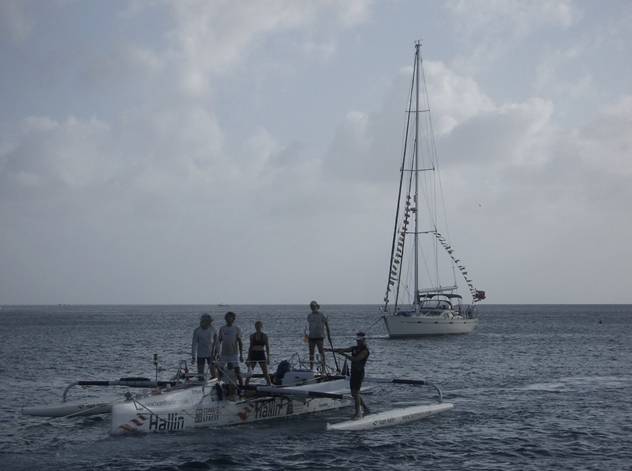Barbados is a friendly, orderly and relatively affluent country. This is partly because of where it's situated, stuck on its own out to the east of the other Caribbean islands. This position made it hard to reach for the Square-rigged sailing ships of old, which were driven back by the prevailing trade winds. And so the country managed to keep out of the frequent battles between the French, British, Dutch and Courlanders (now part of Latvia) that other islands endured. Barbados stayed under British rule for over 300 years, although now it is an independent and stable parliamentary democracy.
 |
| Anchored at Port St Charles (photo courtesy of Tim Bateman) |
Our time at Port St Charles was spent in a social whirl, enjoying incredible hospitality from so many new friends, and sampling that vital by-product of the islands early sugar industry – Mount Gay rum. Having made it here under our own steam, friends were kind enough to make a fuss of us, although our achievements across the Atlantic were soon put into perspective by the arrival of 2 rowing boats!
 |
| Shortly after landfall on a nearby beach, Team Hallin is towed past Ananda |
 |
| The crew of Sara G, arriving in fine fettle. |
All of this made Port St Charles very difficult to leave. We did eventually manage it (though not for too long!) and sailed down to the lee of the island to Bridgetown. Here, thanks to Peter, Vice Commodore, we enjoyed the facilities of Barbados Yacht Club as honorary members. At its shady waterside restaurant we ate delicious flying fish cutters washed down with a rum punch, whilst enjoying the use of a safe club mooring in the deep waters of Carlisle Bay.
 |
| When it comes to selling hats, Cynthia can see one coming! |
Then sadly goodbyes all round – to Pete and Vic, hopefully returning home rested and slowed to a Caribbean pace, and also to all our new friends.
And so, on 21st February, we set sail for Tobago, one of the last unspoiled Caribbean islands lying 150 miles to the SW off the coast of Venezuela. The winds were fresh, and we spent part of the night passage in company with 'Sea Princess', a large cruise ship. Eventually, in rather confused seas, we rounded the NE tip of the island the following day to arrive at Scarborough where we anchored just off the liner's stern.
Scarborough is a bustling Caribbean port full of stalls playing cheerful loud music. But, a little off the beaten track at a deserted quay, we were upset to find fishermen butchering two turtles, one probably weighing over 200 lbs. As tourists, we have to accept that a local fisherman who depends on the sea for his livelihood may well have a different priority when it comes to preserving endangered species.
The next day, we sail round to Store Bay, a pretty anchorage next to the famous Buccoo reef. However, there is a sombre mood over the bay. Two days earlier, a Norwegian Beneteau 45 had been washed up on the rocks when its mooring buoy parted during the night. The crew were aboard at the time, though fortunately escaped serious injury. But the boat was a complete write off. With virtually no yacht facilities on the island to speak of, all that could be done was to break it up and remove the wreckage to be shipped off the island by container – a task quickly achieved, as we watched, with a mechanical digger.
Eerily, whilst swimming on a nearby reef, we came across the remains of another yacht broken up on the seabed and looking rather like an anatomy dissection from a yacht textbook. We later learned that exactly the same thing had happened to this English yacht only 5 months earlier! Once again, the yacht was a complete write off, and, sadly, the owner had been uninsured. Moral – don't trust mooring buoys.
 |
| Baptism Tobago style - on the beach |
 |
| Jennifer's fruit and veg store, appropriately situated in Store Bay |
Must go now, time for a swim!










